-
Feeling isolated? You're not alone.
Join 20,000+ people who understand exactly how your day went. Whether you're newly diagnosed, self-identified, or supporting someone you love – this is a space where you don't have to explain yourself.
Join the Conversation → It's free, anonymous, and supportive.
As a member, you'll get:
- A community that actually gets it – no judgment, no explanations needed
- Private forums for sensitive topics (hidden from search engines)
- Real-time chat with others who share your experiences
- Your own blog to document your journey
You've found your people. Create your free account
You are using an out of date browser. It may not display this or other websites correctly.
You should upgrade or use an alternative browser.
You should upgrade or use an alternative browser.
2022 Greenhouse/Gardening Chronicles
- Thread starter Magna
- Start date
@Callistemon I splurged and bought this a few years ago when I was going to start up an organic farm. I call it GOAT. I have a slightly smaller one I call BILLY. GOAT cuts brush and saplings up to 3"-4" in diameter almost like they're weeds when the saw blade is sharp. It comes with a really nice padded harness that it clips on to so moving it side to side is very easy.
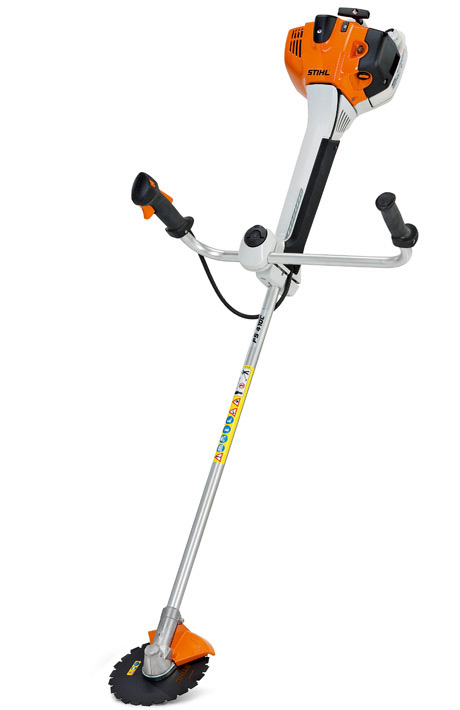

This is great, @Magna, and we were looking for one, but they stopped selling them in Australia for quite a while because some idiot sliced their foot off with it apparently. Yes, I know. Will they also stop selling flame throwers because someone toasted themselves with one? OMG...
We want this tool for maintaining the edges of our bush tracks.
We want this tool for maintaining the edges of our bush tracks.
Taking the chain off the saw is not an issue - it's a pole saw. But I already have this power tool and can't refund it after two years...
Sorry @Magna, a pole saw is not a greenhouse...
I just have a quick tip, I have learned that if you find a new tool that is better than the tool you have, it's usually smart to get the new tool. Because better tools saves you time and energy and money.
This is great, @Magna, and we were looking for one, but they stopped selling them in Australia for quite a while because some idiot sliced their foot off with it apparently. Yes, I know. Will they also stop selling flame throwers because someone toasted themselves with one? OMG...
We want this tool for maintaining the edges of our bush tracks.
That's some feat (no pun intended) of acrobatics that person must have done to injure themselves that way. The "clearing saw" as it's known as is safer for me to use on brush and bramble than a chainsaw because the saw blade is so far away and in front of me that it's nearly impossible (I guess not completely impossible from the sounds of it!) to cut myself from it. Whereas if I cut brush and bramble with a chainsaw I'm having to crouch down to get to the base, trunks of the bushes in awkward and imbalanced ways also sometimes having to extend my arms far outward which gives less command and control of the chainsaw. Never a good idea.
Yeah, @Magna, that guy must have been seriously talented, and maybe practicing for the circus...
At the moment we're getting a contractor with a tractor plus slasher to clear the sides of our 2km valley loop track every year or two. But they're hard to get, so touching up would be nice in-between, and that tool would be just the ticket.
Our (adjustable length) pole saw is mainly used for trimming high branches, and for cutting tree fodder from our tagasaste hedges and fodder acacias.
These heifers are eating acacias for roughage and protein as a mid-winter top-up:

This is a tagasaste hedge, with cattle eating trimmed branches. The horses have long necks and help themselves over the sides of the electric fence, thus keeping the hedge trimmed horizontally - I lop the hedge vertically.
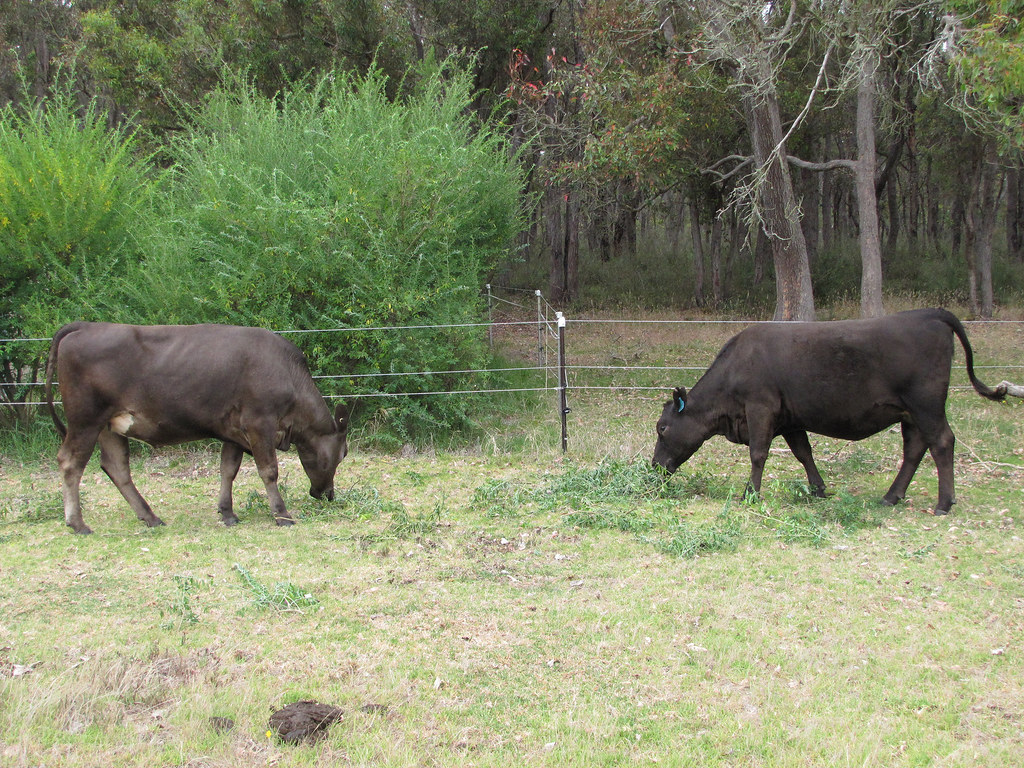
We planted 800 seedlings in 2012 to make these hedges. They provide mid-winter flowers for our beehives, high-protein feed and shelter for our livestock, nesting places and insects for the birdlife, and a green firebreak around our place to help protect against bushfires (as the tagasaste is very lush and contains no flammable oils - it serves as an ember catcher and will also slow down a fire front).
You can see more photos of our tagasaste (tree lucerne) hedges and fodder acacias and the feeding out here: Tree fodder
At the moment we're getting a contractor with a tractor plus slasher to clear the sides of our 2km valley loop track every year or two. But they're hard to get, so touching up would be nice in-between, and that tool would be just the ticket.
Our (adjustable length) pole saw is mainly used for trimming high branches, and for cutting tree fodder from our tagasaste hedges and fodder acacias.
These heifers are eating acacias for roughage and protein as a mid-winter top-up:

This is a tagasaste hedge, with cattle eating trimmed branches. The horses have long necks and help themselves over the sides of the electric fence, thus keeping the hedge trimmed horizontally - I lop the hedge vertically.

We planted 800 seedlings in 2012 to make these hedges. They provide mid-winter flowers for our beehives, high-protein feed and shelter for our livestock, nesting places and insects for the birdlife, and a green firebreak around our place to help protect against bushfires (as the tagasaste is very lush and contains no flammable oils - it serves as an ember catcher and will also slow down a fire front).
You can see more photos of our tagasaste (tree lucerne) hedges and fodder acacias and the feeding out here: Tree fodder
So right! I learned through mistakes. I've had a moderately good John Deere compact tractor, but with winters getting icier it was not good on a sloping driveway. I could only plow downhill and was frustrated when it would lose traction and I'd have to drag it uphill with my car. Finally got a nice Kubota and it is saving me a lot of aggrivation.I just have a quick tip, I have learned that if you find a new tool that is better than the tool you have, it's usually smart to get the new tool. Because better tools saves you time and energy and money.
Another evening from a "second job" is done. I call working around the homestead and in the garden during the work week my "second job" since I still work my regular job during the week. Thankfully I like my "second job" which helps me make up for not liking my regular job.
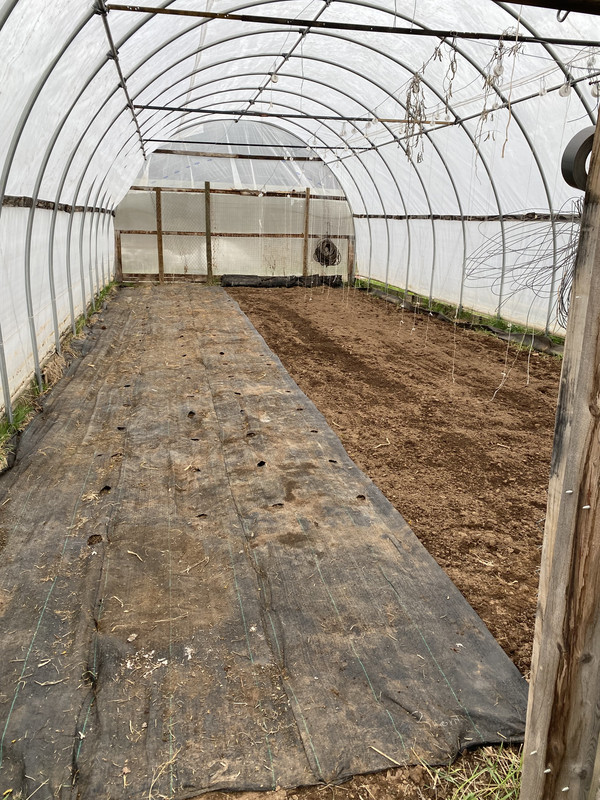
^ Half of the ground cover is laid back down after I tilled the soil with a rototiller. I started the left-most strip of fabric too close to the long edge of the greenhouse where I have some marginally effective weed cover strip that I leave in place. More on the "mistake" a few pictures down. The grass growing along the long edge of the greenhouse is far enough away from the first row of veg that I'll likely spray that grass with a vinegar solution and a tad of biodegradable dish soap and it shouldn't affect the veg but will dry up the grass.
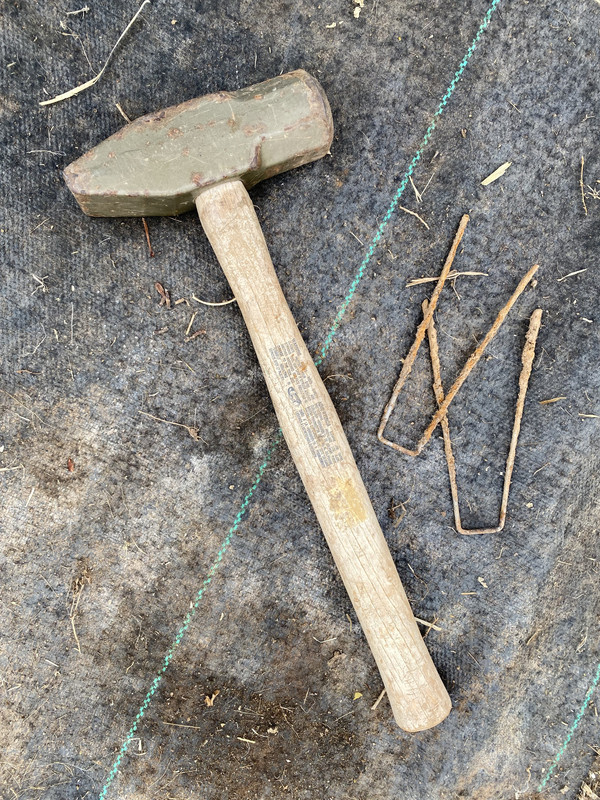
^ The ground cover fabric, a commercial grade, is fastened to the soil using the staples you see in the above picture. They're six inches long if I recall correctly. I reuse the staples each year. They get rusty, but that has no effect. I overlap each strip of fabric by about 4 inches so the staples punch through two layers of that fabric. A hammer is a must for driving them in. The first year I did this I didn't use a hammer and instead pushed and hammered the staples in with the open palm of my hand. Trust me, a bruised palm is more painful that you might think!
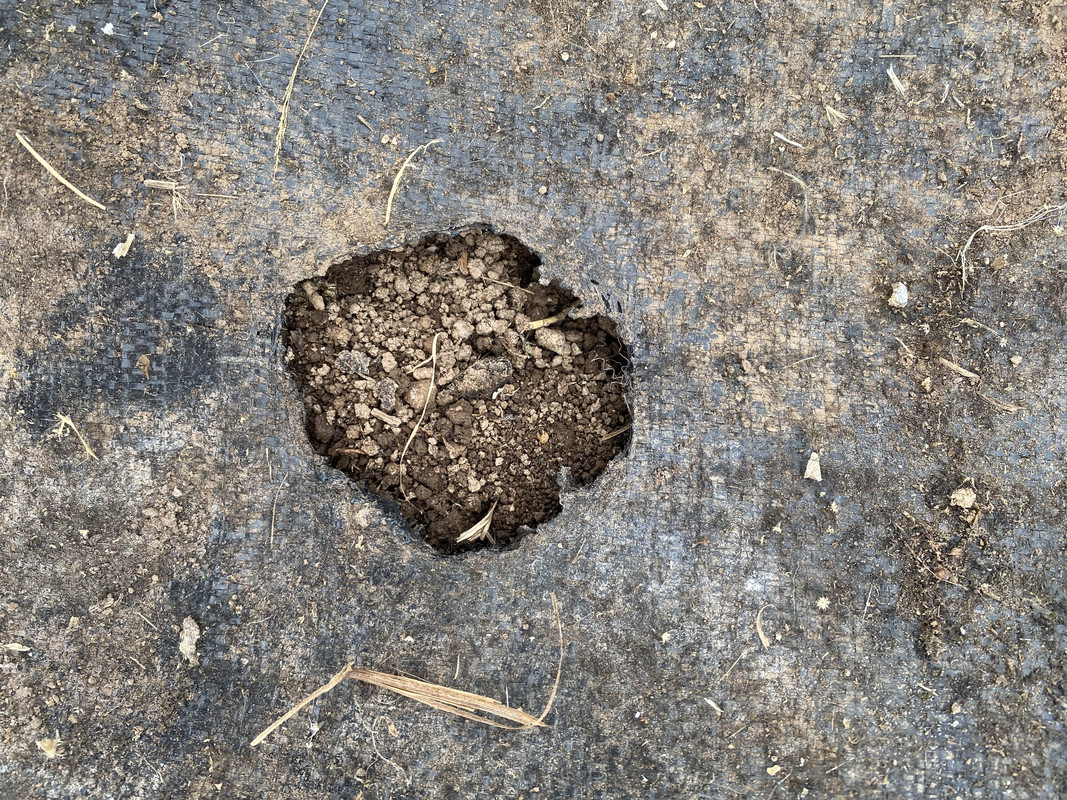
^ A close up of one of the holes. The ground cover fabric is made of woven polypropylene. As such, cutting holes would result in the fabric fraying and unraveling which would decrease it's usefulness for its intended purpose. All of the holes are burned into the fabric. I made a jig out of plywood and a hole cutting drill bit. The jig has a wooden handle on each end. It's a four person job to make the holes but once they're done, you never have to make the holes in the fabric again. Two people to pick up the jig, move it to the next section and set it down. One person to man the weed torch and the fourth person handles the 20 pound propane tank to turn it off immediately as needed (e.g. when adjusting the jig takes too long, when the strip is done and the next one needs to be set up, etc). It takes care, concentration and finesse to burn the holes correctly. Distraction or the flame too high or too close for too long and the holes can become far too large too quickly. What does the flame do? It melts the material thereby fusing the fabric ends together so they can't fray.
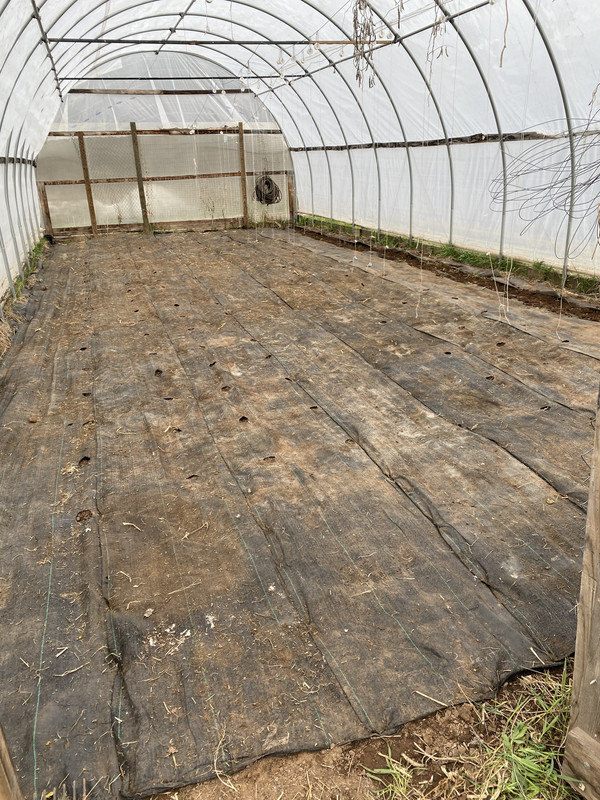
^ Done! Forgive the ugliness of the ground cover. It will look nicer after I give it a nice rinse with a hose which will also give the soil under the ground cover fabric a good soaking. If you look at the right-most length you'll see a strip of exposed soil. Oops! My mistake. I first thought I'd cover that with some weed fabric. But then I had an idea...
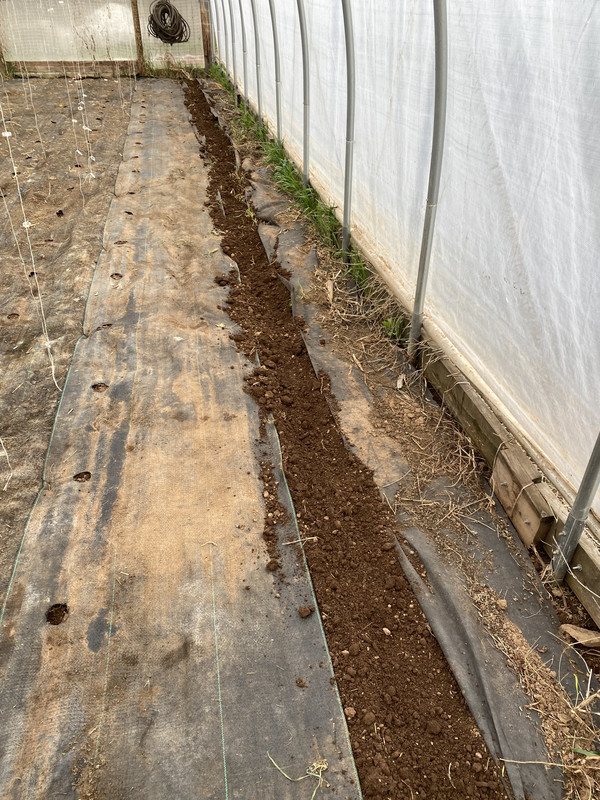
That's where I'll plant spinach. I've planted spinach in the greenhouse before when we just worked open soil (pre-ground cover days) and it's ideal for spinach. Nightly huge salads...here we come! The spinach does bolt later when the summer gets to what our version of "hot" is (probably warm to those who live in hot climates) but not before we get tons of great fresh greens.
That's it for this installment. Next step in the greenhouse will be repositioning the overhead support wires so I have a wire above each row of holes. After that?...planting the tomato and pepper seedlings that are screaming at me to get them in the ground.

^ Half of the ground cover is laid back down after I tilled the soil with a rototiller. I started the left-most strip of fabric too close to the long edge of the greenhouse where I have some marginally effective weed cover strip that I leave in place. More on the "mistake" a few pictures down. The grass growing along the long edge of the greenhouse is far enough away from the first row of veg that I'll likely spray that grass with a vinegar solution and a tad of biodegradable dish soap and it shouldn't affect the veg but will dry up the grass.

^ The ground cover fabric, a commercial grade, is fastened to the soil using the staples you see in the above picture. They're six inches long if I recall correctly. I reuse the staples each year. They get rusty, but that has no effect. I overlap each strip of fabric by about 4 inches so the staples punch through two layers of that fabric. A hammer is a must for driving them in. The first year I did this I didn't use a hammer and instead pushed and hammered the staples in with the open palm of my hand. Trust me, a bruised palm is more painful that you might think!

^ A close up of one of the holes. The ground cover fabric is made of woven polypropylene. As such, cutting holes would result in the fabric fraying and unraveling which would decrease it's usefulness for its intended purpose. All of the holes are burned into the fabric. I made a jig out of plywood and a hole cutting drill bit. The jig has a wooden handle on each end. It's a four person job to make the holes but once they're done, you never have to make the holes in the fabric again. Two people to pick up the jig, move it to the next section and set it down. One person to man the weed torch and the fourth person handles the 20 pound propane tank to turn it off immediately as needed (e.g. when adjusting the jig takes too long, when the strip is done and the next one needs to be set up, etc). It takes care, concentration and finesse to burn the holes correctly. Distraction or the flame too high or too close for too long and the holes can become far too large too quickly. What does the flame do? It melts the material thereby fusing the fabric ends together so they can't fray.

^ Done! Forgive the ugliness of the ground cover. It will look nicer after I give it a nice rinse with a hose which will also give the soil under the ground cover fabric a good soaking. If you look at the right-most length you'll see a strip of exposed soil. Oops! My mistake. I first thought I'd cover that with some weed fabric. But then I had an idea...

That's where I'll plant spinach. I've planted spinach in the greenhouse before when we just worked open soil (pre-ground cover days) and it's ideal for spinach. Nightly huge salads...here we come! The spinach does bolt later when the summer gets to what our version of "hot" is (probably warm to those who live in hot climates) but not before we get tons of great fresh greens.
That's it for this installment. Next step in the greenhouse will be repositioning the overhead support wires so I have a wire above each row of holes. After that?...planting the tomato and pepper seedlings that are screaming at me to get them in the ground.
We're doing outside pots this weekend. First summer at the current house we planted veggies in a back bed. We got lots of tomatoes and way too much squash. Next year the thuggy deer in the neighborhood ate everything off. Following year we planted perennials, (including the peony for CatCat). Everything bloomed last year. And everything is thriving thus far.
I'm good with my pretty plants, and will happily leave the veggies to the pros.
I'm good with my pretty plants, and will happily leave the veggies to the pros.
That's a fair bit of work there, @Magna. And first comes the work. Then comes the food, etc.
Here's some bling for your thread. I like planting flowers between my F&V. Makes for a nice "office" and encourages biodiversity and pollination.
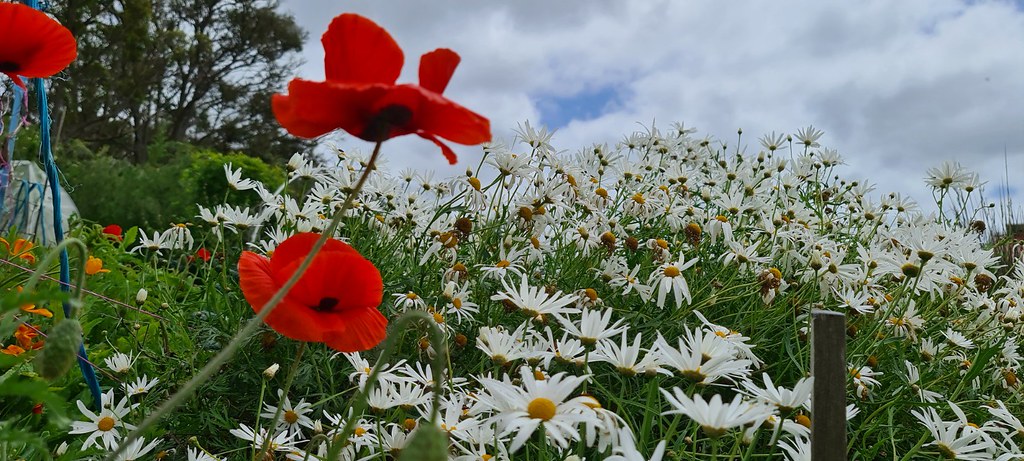
Speaking of, time to get in the garden!
Screaming beetroot seedlings to plant out and also some new seeds for direct sowing.
Here's some bling for your thread. I like planting flowers between my F&V. Makes for a nice "office" and encourages biodiversity and pollination.

Speaking of, time to get in the garden!
Screaming beetroot seedlings to plant out and also some new seeds for direct sowing.
This is the super small front garden of our cottage a few weeks ago, with the wood planters my partner's made, which now we have replanted as the tulips finished, I will post the new look, we are trying out pumpkins in new additional planters, I have a Racer, a Jack o lantern and a Zombie in the front with a mix of blue, red and white flowers we've put in for the Jubilee year, and some will be flowering for the actual Jubilee weekend at the start of June, Elizabeth II celebrates 70 years as Queen. We also have bunting.
The little runner beans were on their way to our allotment, which I will post pics of soon, these beans are getting snacked on by something up there now! But lots of other crops are doing nicely the broad beans called Dreadnought are living up to their name.
Last edited:
This is an old thread I stumbled upon while searching for "gardening" threads. It's spring here and I have some old Yukon Gold potatoes that I need to either put in the compost pile or plant. They're starting to sprout. A little YouTube research turned up videos of growing potatoes in straw or hay bales.
So, I'm going to use a 2-year-old hay bale to plant the potatoes. Has anyone else done this? It will be my first time to grow potatoes. Suggestions would be welcome!
So, I'm going to use a 2-year-old hay bale to plant the potatoes. Has anyone else done this? It will be my first time to grow potatoes. Suggestions would be welcome!
Potatoes will grow in all sorts of soils. They really want to grow. Probably why they were a staple in England, Ireland, Scotland for hundreds of years. We grow our potatoes in raised beds behind the house. Always a good harvest. Had some with our dinner a few nights ago, in fact.This is an old thread I stumbled upon while searching for "gardening" threads. It's spring here and I have some old Yukon Gold potatoes that I need to either put in the compost pile or plant. They're starting to sprout. A little YouTube research turned up videos of growing potatoes in straw or hay bales.
So, I'm going to use a 2-year-old hay bale to plant the potatoes. Has anyone else done this? It will be my first time to grow potatoes. Suggestions would be welcome!
I haven't tried the straw or hay bale technique yet. However, some day, I would like to play around and experiment with hydroponics or aeroponics.
While it is not spring yet, for the garlic I planted last October, I overwinter them with a top dressing of about 2 inches of straw. Right now I count at least 40 plants coming up. I am looking forward to harvesting the German Red Garlic later this year.
Potatoes will grow in all sorts of soils. They really want to grow. Probably why they were a staple in England, Ireland, Scotland for hundreds of years. We grow our potatoes in raised beds behind the house. Always a good harvest. Had some with our dinner a few nights ago, in fact.
I haven't tried the straw or hay bale technique yet. However, some day, I would like to play around and experiment with hydroponics or aeroponics.
I live in the Deep South so it is hot here with heavy annual rainfall, not exactly prime potato-growing conditions. Potatoes actually are native to the high Andes Mountains.
I have had little luck with potatoes. One needs to be willing to use a lot of chemicals here to fight off the wilts and insects. I’ve tried growing them in raised beds. No luck.
I tried growing potatoes in compost, but they soon get devoured by other things (insects, wilts) although I might get a couple of spuds out of it.
I tried growing some in grass clippings, but the heat from the decomposition killed them.
If you want to check my latitude, I’m along the same line with Lake Okechobee which is easily found on any map. It is the largest lake completely within the US and can be seen from space.
I tried growing potatoes in compost, but they soon get devoured by other things (insects, wilts) although I might get a couple of spuds out of it.
I tried growing some in grass clippings, but the heat from the decomposition killed them.
If you want to check my latitude, I’m along the same line with Lake Okechobee which is easily found on any map. It is the largest lake completely within the US and can be seen from space.
Wish you had better luck . . . though I have not grown potatoes because we have a lot of good spuds in Michigan. Lake Okechobee at 662 sq mi is a fraction of the inland sea of Lake Michigan at 22,300 sq mi. With a surface elevation of 577 feet, It's deepest is 925 feet which puts it below sea level.I have had little luck with potatoes. One needs to be willing to use a lot of chemicals here to fight off the wilts and insects. I’ve tried growing them in raised beds. No luck.
I tried growing potatoes in compost, but they soon get devoured by other things (insects, wilts) although I might get a couple of spuds out of it.
I tried growing some in grass clippings, but the heat from the decomposition killed them.
If you want to check my latitude, I’m along the same line with Lake Okechobee which is easily found on any map. It is the largest lake completely within the US and can be seen from space.
You are correct.Wish you had better luck . . . though I have not grown potatoes because we have a lot of good spuds in Michigan. Lake Okechobee at 662 sq mi is a fraction of the inland sea of Lake Michigan at 22,300 sq mi. With a surface elevation of 577 feet, It's deepest is 925 feet which puts it below sea level.
I revise - with this exception of the Great Lakes.
I have had little luck with potatoes. One needs to be willing to use a lot of chemicals here to fight off the wilts and insects. I’ve tried growing them in raised beds. No luck.
I tried growing potatoes in compost, but they soon get devoured by other things (insects, wilts) although I might get a couple of spuds out of it.
I tried growing some in grass clippings, but the heat from the decomposition killed them.
If you want to check my latitude, I’m along the same line with Lake Okechobee which is easily found on any map. It is the largest lake completely within the US and can be seen from space.
Thanks for the input. I'm an organic household gardener and kind of assumed that the heat, humidity, bugs and diseases would sabotage a potato crop. I'll try the hay bale method to see what happens but don't have high hopes I'll get any edible potatoes. I quit growing tomatoes in the ground years ago due to the bugs and diseases and now grow them in large containers and pots, with a fair amount of success. It seems the best summer crops to grow in the ground here are beans, okra and corn.
I have had only minimal success with tomatoes. The cherry ones tend to do better. I had a volunteer tomato that did amazingly well and somehow I neglected to save seeds or cuttings.Thanks for the input. I'm an organic household gardener and kind of assumed that the heat, humidity, bugs and diseases would sabotage a potato crop. I'll try the hay bale method to see what happens but don't have high hopes I'll get any edible potatoes. I quit growing tomatoes in the ground years ago due to the bugs and diseases and now grow them in large containers and pots, with a fair amount of success. It seems the best summer crops to grow in the ground here are beans, okra and corn.
You could also try eggplant and hot peppers in the summer.
I no longer try to get any vegetable gardening done in summer months. There are some tropical vegetables that grow all year here, perennials.
Share:
New Threads
-
-
Managing insurance authorization paperwork
- Started by megandavitt
- Replies: 1
-
-
Delta orders Boeing 787-10 Dreamliner (30 firm + 30 options)
- Started by Pink Jazz
- Replies: 13
-
-
First autistic Barbie doll launched with sensory-sensitive features
- Started by cooljethro
- Replies: 41
-
-
-
AI vs. CAPTCHA: The New Arms Race...?
- Started by Crossbreed
- Replies: 4
-
What a trip it's been. RIP Bob Weir
- Started by WhitewaterWoman
- Replies: 11